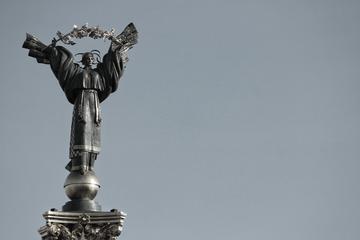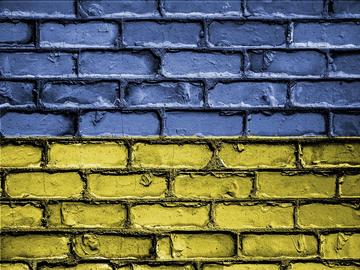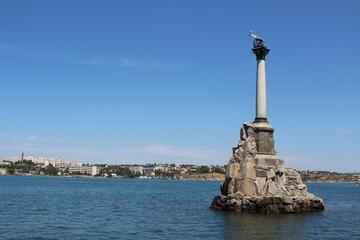The Ukraine Crisis: A Clash of Narratives?
Emma Mateo, UC Fellow - University of Oxford
This this essay was written in October 2018 for the University Consortium Conference, in response to the prompt: “Discuss the narratives used to explain the Ukrainian crisis from three different perspectives - Russian, American, and European Union”. Therefore it does not refer to the election of President Zelensky, ongoing Trump-Ukraine scandal, or discussions of the ‘Steinmeier’ formula for peace in the Donbass.

Introduction
The term ‘Ukrainian Crisis’ is frequently used to refer to the ongoing political upheaval which began in Ukraine during the winter of 2013-14. However, the term is misleading as it refers to a situation which is about much more than domestic Ukrainian politics. The ‘crisis’ is often seen as beginning with the Ukrainian ‘Euromaidan’ protests[1] against President Yanukovych’s unexpected refusal to sign the EU Association agreements (EUAA) in November 2013. And yet, as the protests spread across the country and culminated with the fleeing of the president in February 2014, Ukraine found itself caught between clashing ‘great power’ narratives about what was happening on its territory, and what its future should look like. The aftermath of the Euromaidan saw a new, pro-European government installed; but also the annexation of the Crimean peninsula by Russia, and the outbreak of separatist conflict in the east of Ukraine, stoked and supported by the Kremlin. Relations between Russia and the West soured dramatically as a result of the situation, and the conflict and annexation continue to this day.
This essay will take a step back from the numerous, conflicting narratives about the individual events of the crisis and the short-term factors which contributed to it. Instead, it will discuss broad Russian, US and European Union (EU) metanarratives of the crisis, which are crucial to understanding the long-term causes of the conflict. [2] These metanarratives do not relate directly to Ukraine itself, but rather reflect a clash between these self-perceived ‘great powers’ over the geopolitical orientation of Eastern Europe, with Ukraine caught in the crossfire. Ukraine’s own narratives about the crisis and its right to agency and sovereignty are frequently overshadowed by the narratives of larger powers. Nevertheless, these competing narratives constrain Ukraine’s ability to act, and need to be taken into account. Neither a focus solely on Ukrainian internal politics, nor on Russia-West relations and geopolitics, will resolve the current situation. Unless the current Russia-West tensions caused by these conflicting metanarratives ease, there is little hope of Ukraine being rid of armed conflict, let alone free to make independent choices about its future.
A crisis in the making
The current meta-narratives framing the Ukrainian crisis germinated with the collapse of the USSR. Since 1991, Russia, Europe and the US have been using different narratives to frame the post-Soviet space. For Russia, the formerly Soviet, Central and Eastern European states remained its privileged zone of influence – let’s call this this Russia’s ‘sphere of influence’ metanarrative. Russia’s attitude towards its neighbouring states is reflective of its policy of derzhavnost, with the idea that there are only a few ‘great powers’ which are ‘truly sovereign states’. As most of the post-Soviet states are not ‘truly sovereign’, Russia believes it can treat them as it sees fit.[3] In line with this narrative, Russia has been working towards exerting influence in the region since the 1990’s: first with efforts such as the Collective Security Treaty Organisation (CSTO) and Commonwealth of Independent States (CIS), later followed in the 2000’s by the Customs Union and Eurasian Economic Union (EEU). Through these supranational bodies, Russia has been vying to influence the trade, foreign policy and security of states in its ‘near abroad’. Creating this ‘sphere of influence’ is key to securing Russia’s vision of itself as a great power in a multi-polar world; whilst also bolstering Putin’s image and consolidating his power domestically.[4]
Meanwhile, EU policy since 1991 has increasingly engaged with the states between its borders and Russia, through the European Neighbourhood Policy (ENP) and later Eastern Partnerships (EaP). The EU did not see Russia as having any special status in the region. Rather, the EU envisioned expanding a network of democratic, market-oriented states, governed by the rule of law, into what is saw as its own ‘near abroad’. Let’s call this the ‘European neighbourhood’ narrative. Although EU policy on the region was not officially ‘zero-sum’, a pervasive view developed in the EU that the EaP offered a ‘civilisational choice’ for Eastern Europe, distinct from that of Russia.[5] There was little engagement with Russia during the development of the ENP and EaP, which if not a deliberate attempt to sideline Russia, was nevertheless ‘naive’ and ‘arrogant’.[6] Russia had in fact been clear with the EU and US that it would defend its interests in Ukraine.[7] Whilst the EU saw these policies as benign efforts to lead reform and development in the region, Moscow saw them as hindering its ‘Eurasian’ project and trying to assert Western ideals for strategic goals.[8]
What about US views of the post-Soviet space? Since 1991, the US has seen the growth of democratic institutions and human rights in the region, along with NATO expansion, as desirable and an unmitigated good. We can call this the ‘Euro-Atlantic community’ narrative. Washington failed to address how its support for democracy and the Colour Revolutions of the 2000’s was perceived by Russia as a tool to enact US policy in the region.[9] Moscow feared being surrounded by hostile states, and the possibility that the West could attempt to foment regime change in Russia. The ‘counter revolutionary regional policy’ which Russia pursued in the years following the Colour Revolutions was seen by the West as an attempt to undermine democratic norms. However, it is possible that Russia was not necessarily promoting authoritarianism, and rather just wanted ‘friendly’ states on its borders.[10]
Thus, since the 1990’s, the EU, US and Russia have all held different narratives about Eastern Europe’s future: a Russian ‘sphere of influence’, a ‘European neighbourhood’, or part of the ‘Euro-Atlantic community’. These visions relate not only to geo-economics but also questions of which norms, values and actors should influence the region, and therefore a zero-sum game has developed. This contestation over the geopolitical orientation of this formerly Soviet neighbourhood, with Ukraine its biggest and most significant country, is a key cause of the Ukraine Crisis. Arbatova sees the Ukraine Crisis as the ‘first direct conflict between differing regional strategies of Russia and the EU’. [11] Ukraine is key to both strategies, and found itself caught between the EU and the Customs Union: 33% and 29% of its external trade was shared between these partners respectively.[12] By 2012-13 both Moscow and Brussels were pressuring Ukraine with an ‘either/or’ choice - to sign an EU association and trade agreement, or move towards joining the EEU. Neither Moscow nor Brussels were trying to find a way by which Ukraine itself could benefit from both options.[13] Whichever option Ukraine chose, a backlash was likely from the ‘losing’ side, unwilling to relinquish the country core to its Eastern European vision, and fearing the outcome of victory for the opposing side.

Not only are the three narratives discussed above incompatible, but these narratives have also frequently been misunderstood or misinterpreted by the different parties. The EU and US perceive Russia’s ‘sphere of influence’ narrative as part of a plan to gain control over the country and region, create a network of authoritarian states, and perhaps even rebuild the Soviet Empire. Russia sees EU and US desires to ‘Westernise’ Ukraine as part of a plan to undermine its influence, bring NATO to its borders, and ultimately weaken Russia and enact regime change. These misunderstandings lead to cognitive dissonance, which creates a serious barrier to resolving conflicts around Ukraine: how can actors resolve a problem, if they do not agree on what the problem is?
Revolution and geopolitical wrangling
In this context, Yanukovych's last-minute turnaround and refusal to sign the EUAA in November 2013 was seen as a victory by Russia, which had exerted much pressure on Kyiv in preceding months.[14] Yanukovych’s refusal was a sign that Ukraine had not yet committed to pursuing a European path, which would lead it away from Moscow’s vision for the region. However, as protests against Yanukovych escalated and the president was pressured by both his own people, and the West, to sign the agreement, Russia perceived Western encouragement of Euromaidan as an action which ‘undermined Russia’s privileged interests’.[15] The violent repression of the protests in Kyiv – perhaps even encouraged by Moscow - sparked outrage amongst protesters, and saw their demands widen from the signing of the EUAA to the resignation of Yanukovych.[16] The possible removal of Yanukovych, who was willing to work with Russia, presented an even bigger threat to Moscow: it could lose its significant influence over Ukraine’s government. Hence Russian narratives about Maidan being a Western-sponsored protest, and the overthrow of Yanukovych being a ‘fascist’ coup, can be traced back to Moscow’s belief that Ukraine, and Eastern Europe, belong in its sphere of influence. Moscow needed to de-legitimise the protests and Ukraine’s pro-EU leadership in order to perpetuate its narrative that Ukraine naturally leans towards Russia. Some Russian elites were convinced that Yanukovych’s overthrow was engineered by Western leaders in order to end Russia’s EEU plans and bring NATO to Ukraine. This was seen as a means of constraining Russia’s power and maybe even challenging the Russian political system.[17]
As protests grew and spread across Ukraine throughout winter 2013-14, the US and EU also remained determined to ‘influence events to gain advantage in their contest over Ukraine’.[18] Their attempts to resolve the situation reflected EU and US beliefs that Ukraine should take a pro-Western orientation: Western leaders urged Yanukovych to compromise with pro-Western opposition figures; the EU further pressured Yanukovych to sign the EUAA, offering financial incentives; and US officials were involved in attempts to reach a settlement between the government and protesters. Charap and Colton highlight leaked recordings which capture US officials attempting to select opposition politicians for the new government.[19]
Despite their conflicting narratives, the EU and Russia managed to work with the Ukrainian government. By 21st February 2014 they had negotiated a deal in hopes to end the protests, which had escalated to deadly levels of violence. The deal would restore the 2004 Ukrainian constitution (curtailing the president’s power), set the stage for planned elections, create a weapons amnesty, and end the occupations of government buildings by protesters - effectively a ‘pacted’ transition.[20] The cooperation of the EU and Russia on this deal was possible because the deal did not preclude ‘victory’ for either side: violence and instability would be de-escalated, Yanukovych would remain in power for the time being (appeasing Russia), and the planned elections left Ukraine’s future geopolitical orientation undecided. However, the deal collapsed due to domestic factors: protests escalated, the police deserted their posts, Yanukovych fled, and the Ukrainian parliament impeached him.[21]
After Yanukovych fled, a new, pro-EU provisional government was cobbled together by protesters in Kyiv. This appeared to be a positive outcome for Western visions of the region, and a blow to Russia. The US was quick to legitimise the ‘victory’ of its narrative, declaring support for the new authorities. The EU was also quick to accept the outcome, regarding Yanukovych’s legitimacy as undermined in the eyes of the Ukrainian people. However, the OSCE had approved Yanukovych’s election as democratic,[22] and his impeachment did not technically follow Ukraine’s constitution. Russia highlighted these two facts in an attempt to highlight the hypocrisy of the EU’s supposed stance on promoting democratic norms, rule of law and constitutionalism. Russian narratives accused the EU of having questionable motives behind its democratising agenda.[23] Moscow framed the new government as a coup, supported by the West who deliberately wrecked the brokered deal in order to put in place a loyal government.[24] At this key turning point of the crisis, the US, EU and Russian evaluations of the situation appear more reflective of whether the outcome was of geopolitical advantage to them, than whether it was beneficial for Ukraine and reflected the will of the Ukrainian people.
Conflict and continued competition
Since February 2014, the Ukrainian crisis has significantly escalated. Although there is no longer bloodshed on the streets of Kyiv, Crimea has been annexed by the Russian Federation, and a swathe of the Eastern Donbass region is mired in conflict between the Ukrainian state and pro-Russian separatists, unofficially supported by Russian forces. Russian meta-narratives of the annexation and conflict continue to reflect the idea that Ukraine is part of Russia’s sphere of influence.
Putin framed the ‘coup’ on 22nd Feb as ‘creating a new playing field, as changing the rules of the game’.[25] Ukraine’s new government was seen as illegal, a new state, which nullified Russia’s existing ties and agreements with Kyiv. This key turning point was used by Russia as justification for military incursions into Ukrainian territory, in order to ‘protect’ Russians and Russian speakers it deemed to be under threat. Moscow can also be seen as taking advantage of a moment of instability in order to attempt to reassert its control over a key country in its sphere of influence.
In his 18th March 2014 speech marking the annexation of Crimea, Putin asserted Russia’s historical claim to Crimea and the Russophone populations of Ukraine. He cited the civilisational unity of Ukraine, Russia and Belarus, and claimed that ‘nationalists, neo-Nazis, Russophobes and anti-Semites’ controlled the new Ukrainian government.[26] Putin repeatedly emphasised the close links between Russia and Ukraine, argued that parts of Ukraine used to ‘belong’ to Russia, and used legal justifications to legitimise Russia’s annexation of Crimea. Meanwhile, Russia framed Ukrainian attempts to restore control of the Donbass region as humanitarian crimes by the illegal government against its own people. In contrast, Russia’s actions were ‘humanitarian intervention’ to protect Russophones and ethnic Russians.[27] The fact that Russia would see itself responsible for intervening in this situation again implies that it sees itself as an important power in the region. The speech also made it clear that Russia does not see Ukraine as an independent, sovereign country.
However, Western observers saw the annexation of Crimea as a ‘textbook case of international aggression’, violating security norms, reneging on the Budapest Memorandum of 1994, and breaking the Treaty of Friendship, Cooperation and Partnership.[28] The prevailing narrative in many Western states with regards to the ongoing conflict is that Russia is trying to destabilise Ukraine and its new, pro-Western government, hoping that the government and its reforms will fail and the country will pivot back towards Russia. Cooley points out that Russia has many instruments, actors and tools that can be used to exert its influence, and frozen conflicts such as the Donbass are one such useful tool.[29] Such conflicts enable Russia to play a role in peace negotiations, influence the different sides, and restrain states from actively joining NATO or the EU.

Since the annexation of Crimea, the West and Russia have ‘effectively doubled down on the very policies that precipitated crisis’ [30] - namely their geopolitical contestation of the space. Russia has become militarily involved in Ukraine in attempts to prevent the new government succeeding and Kyiv pivoting towards Europe. The EU and US have lent support to Kyiv in terms of aid, loans, NATO support, and access to markets, seeking to create a ‘reformed, secure, Western integrated Ukraine’.[31] All three powers are still seeing to secure and consolidate their influence over Ukraine. The result of this situation is a stalemate: the EU and US are trying to deepen Western integration with Ukraine and end what they see as Russian aggression; whilst Russia still has not relinquished total control of Ukraine, wants to see existing integration rolled back, and Ukraine veer from the path of EU integration and potential NATO membership.[32] The same narratives that pushed Kyiv to choose between Russia and the West, contributing to the Euromaidan, now risk perpetuating the crisis. Even if Russia and Ukraine manage to implement the Minsk II agreements, ‘the core contestation between Russia and the West will be no closer to resolution’.[33]
Conclusion: Where to go from here?
What is the way out of this geopolitical stalemate, with Ukraine caught between great power narratives that only seem to exacerbate the crisis? As discussed in this essay, Western and Russian narratives about the Ukraine crisis have created a zero-sum game, and the absence of common ground makes negotiating a compromise incredibly difficult. Moreover, a key flaw in all these narratives is that they do not prioritise what may be best of Ukraine, or what the Ukrainian people want. Merry compares Ukraine to an ‘international crime scene, like a neighbourhood cursed as the sparring ground of rival gangs’.[34] The current stalemate is damaging Western and Russian relations and having an impact on their economies and societies, but there is also a tangible, real human cost for Ukraine: thousands killed, tens of thousands wounded, and over 1.6 million displaced within and beyond Ukraine’s contested borders.[35]
Some scholars and analysts have highlighted the need for dialogue between the EU, US and Russia - not about the Ukrainian Crisis, but about broader questions concerning the metanarratives discussed in this paper: who has a right to control the post-Soviet space of Eastern Europe. Arbatova has suggested a grand peace forum between the different actors to deal with the ‘unfinished job of the 90’s’. She has suggested that the path to regional security involves guaranteeing the neutral status of key countries, the military de-escalation of NATO and Russia, and the reconsideration of plans for Eastern Europe’s economic development and EU association, taking into consideration Russia’s interests.[36] Cooley has suggested that the West must take a new approach, respecting the sovereignty of CIS states, allowing them more room to maneuver between Russia and EU, and allowing EU and NATO allies to establish CSTO and EEU ties. He also recommends the mutual consultation of Russia and the West in the event of future upheaval in Eastern European states. This would enable actors to communicate their intentions, prevent conflicting narratives and misunderstandings leading to escalation.
However, suggestions about enforcing the neutrality of certain states, such as Ukraine, are problematic because they deny smaller states the agency to define their own foreign policy. Moreover, after such a divisive conflict as the Ukrainian Crisis, with polarising rhetoric coming from all sides, it seems unlikely that all states in the region would want to remain neutral, or pursue a bi-vector foreign policy. The time for such suggestions was pre-2013: that time has now passed for Ukraine, at least. It is highly improbable that in the near future Ukraine would again start to pursue bi-vector foreign policy between the EU and Russia, even if institutionally possible. Yet, given the persistence of Russian narratives about its sphere of influence and Western motives for incursion into Eastern Europe, Moscow is unlikely to tolerate a Ukraine which continues to shift towards the West.
The EU, Russia and US do need to create some kind of platform to engage with one another and discuss their visions for the post-Soviet space. They need to communicate their intentions for the region and work to dispel any misunderstandings about one another’s motives. Otherwise any progress made on the Ukraine Crisis is likely to be temporary, as underlying geopolitical tensions will surely rise to the surface again in the future. Space also needs to be made for other states in the region to pursue a bi-vector policy of links with Russia and the EU, if they so wish. However, it is crucial that Ukraine and other post-Soviet states are included in such platforms in order to express their own visions and concerns for their futures - particularly with regard to neutral status and economic development. History has shown us that when larger powers impose their visions upon smaller states, this can feed discontent, populism, and even lead to revolution, conflict and war. Failure of Russia, the US and EU to respect Ukraine’s sovereignty and interests lead to the current crisis: any credible resolution to the crisis must address this issue, in addition to the metanarratives of larger powers.
Notes:
[1] The name ‘Euromaidan’ combines the initial ‘European’ focus of the protest, and the Ukrainian word for a town square - 'maidan'. When the focus shifted away from European integration, many protesters and observers took to simply calling the protest ‘the Maidan’. During its later stages, the protests also became known as ‘The Revolution of Dignity’.
[2] A metanarrative is a narrative which ‘provides a schematic world view’ upon which an actor’s ‘experiences and perceptions may be ordered’ (Oxford English Dictionary).
[3] E Wayne Merry, ‘The Origins of Russia’s War in Ukraine: The Clash of Russian and European “civilizational Choices” for Ukraine’, in Roots of Russia’s War in Ukraine., by Elisabeth A. Wood, William E. Pomeranz, and Maxim Trudolyubov (Columbia University Press, 2016), 27–50.
[4] Alexander Cooley, ‘Whose Rules, Whose Sphere? Russian Governance and Influence in Post-Soviet States’, Task Force White Paper, Task Force on U.S. Policy Toward Russia, Ukraine, and Eurasia (Carnegie Endowment for International Peace, 2017), https://carnegieendowment.org/2017/06/30/whose-rules-whose-sphere-russia....
[5] Merry, ‘The Origins of Russia’s War in Ukraine: The Clash of Russian and European “civilizational Choices” for Ukraine’, 36.
[6] Robert Legvold, ‘How East and West Alike Compounded Ukraine’s Troubles’, The National Interest, March 2014, https://nationalinterest.org/commentary/how-east-west-alike-compounded-u... Neil MacFarlane and Anand Menon, ‘The EU and Ukraine’, Survival 56, no. 3 (2014): 95–101.
[7] Adrian Blomfield and James Kirkup, ‘Stay Away, Vladimir Putin Tells Nato’, The Daily Telegraph, April 2008.
[8] Roy Allison, ‘Russian “deniable” Intervention in Ukraine: How and Why Russia Broke the Rules’, International Affairs 90, no. 6 (2014): 1255–1297.
[9] Samuel Charap and Timothy J Colton, Everyone Loses: The Ukraine Crisis and the Ruinous Contest for Post-Soviet Eurasia (Routledge, 2018), 74–79.
[10] Charap and Colton, 77.
[11] ‘Geopolitical Challenges for the Post-Bipolar Europe’, Eastern Journal of European Studies 7, no. 2 (2016).
[12] MacFarlane and Menon, ‘The EU and Ukraine’.
[13] Legvold, ‘How East and West Alike Compounded Ukraine’s Troubles’.
[14] Charap and Colton, Everyone Loses: The Ukraine Crisis and the Ruinous Contest for Post-Soviet Eurasia, 118.
[15] Cooley, ‘Whose Rules, Whose Sphere? Russian Governance and Influence in Post-Soviet States’.
[16] Olga Onuch and Gwendolyn Sasse, ‘The Maidan in Movement: Diversity and the Cycles of Protest’, Europe-Asia Studies 68, no. 4 (20 April 2016): 556–87, https://doi.org/10.1080/09668136.2016.1159665.
[17] Allison, ‘Russian “deniable” Intervention in Ukraine: How and Why Russia Broke the Rules’.
[18] Charap and Colton, Everyone Loses: The Ukraine Crisis and the Ruinous Contest for Post-Soviet Eurasia, 123.
[19] Everyone Loses: The Ukraine Crisis and the Ruinous Contest for Post-Soviet Eurasia.
[20] Charap and Colton.
[21] Charap and Colton.
[22] OSCE, ‘Ukraine, Presidential Election, 17 January and 7 February 2010: Final Report’, 2010, https://www.osce.org/odihr/elections/ukraine/67844.
[23] MacFarlane and Menon, ‘The EU and Ukraine’, 99.
[24] Charap and Colton, Everyone Loses: The Ukraine Crisis and the Ruinous Contest for Post-Soviet Eurasia.
[25] Allison, ‘Russian “deniable” Intervention in Ukraine: How and Why Russia Broke the Rules’, 1257.
[26] BBC News, ‘Putin’s Full Crimea Speech Annotated’, BBC, March 2014.
[27] Allison, ‘Russian “deniable” Intervention in Ukraine: How and Why Russia Broke the Rules’.
[28] Cooley, ‘Whose Rules, Whose Sphere? Russian Governance and Influence in Post-Soviet States’.
[29] Cooley.
[30] Charap and Colton, Everyone Loses: The Ukraine Crisis and the Ruinous Contest for Post-Soviet Eurasia, 131.
[31] Charap and Colton, 133.
[32] Charap and Colton, Everyone Loses: The Ukraine Crisis and the Ruinous Contest for Post-Soviet Eurasia.
[33] Charap and Colton, 145.
[34] Merry, ‘The Origins of Russia’s War in Ukraine: The Clash of Russian and European “civilizational Choices” for Ukraine’, 46.
[35] Global Conflict Tracker, n.d., https://www.cfr.org/interactives/global-conflict-tracker#!/conflict/conf....
[36] Alexandrova-Arbatova, ‘Geopolitical Challenges for the Post-Bipolar Europe’.



